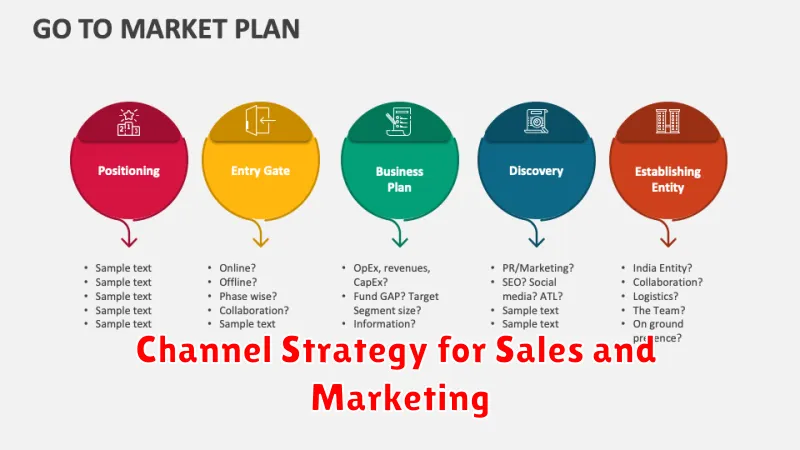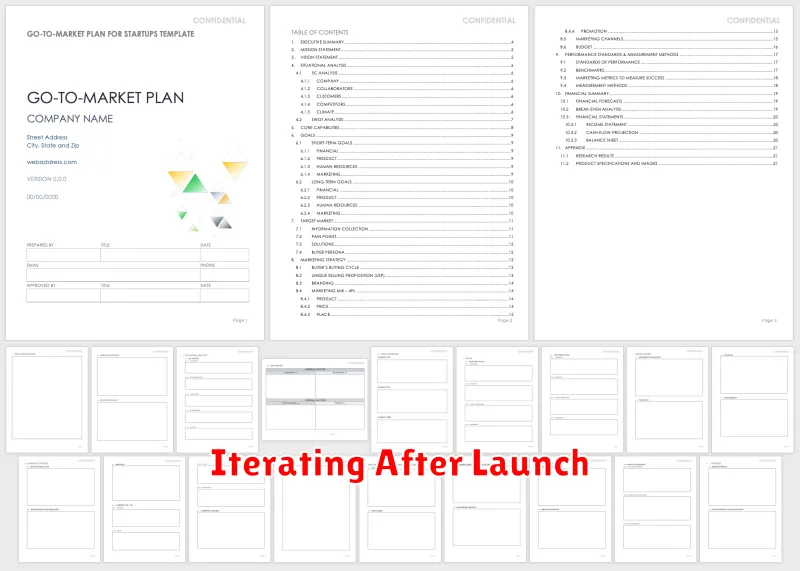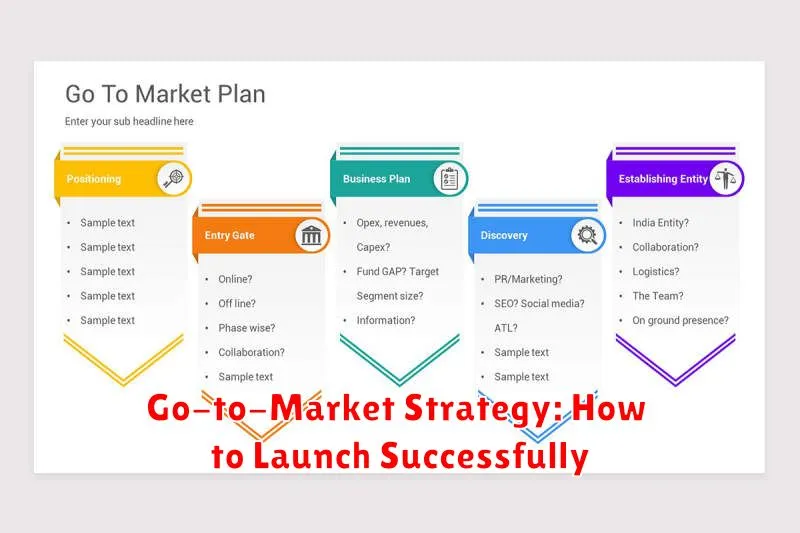A go-to-market strategy is a comprehensive plan that outlines how a company will bring a new product or service to market and achieve its target audience. A well-defined go-to-market strategy is crucial for a successful product launch, ensuring resources are used effectively, and maximizing the potential for market penetration and profitability. This article will guide you through the essential components of a go-to-market strategy, offering practical advice and insights to help you navigate the complexities of a product launch and build a successful go-to-market strategy.
From market research and target audience identification to marketing and sales strategies, a robust go-to-market strategy covers all aspects of a product launch. Understanding your competitive landscape, defining your value proposition, and establishing clear marketing messages are key elements in achieving a successful product launch. By following the steps outlined in this article, you can develop a comprehensive go-to-market strategy that will position your product for success and drive sustainable growth. Whether you are launching a new product or expanding an existing one into a new market, a well-executed go-to-market plan is essential for achieving your business objectives and securing a strong market position.
What Is a Go-to-Market (GTM) Strategy?
A go-to-market (GTM) strategy is a detailed plan that outlines how to reach target customers and achieve business objectives. It’s a roadmap for introducing a new product or service to the market, or even for relaunching an existing offering. A strong GTM strategy considers key elements such as target audience, value proposition, marketing channels, and sales execution.
Essentially, it answers the question: How will we successfully bring this offering to market and ensure sustainable growth? A well-defined GTM strategy is crucial for maximizing revenue and establishing a competitive edge.
Target Audience and Segmentation
A clearly defined target audience is crucial for a successful go-to-market strategy. Understanding your ideal customer allows for effective resource allocation and maximizes marketing ROI.
Target audience segmentation involves dividing your broader target market into smaller, more homogenous groups based on shared characteristics. Common segmentation criteria include demographics (age, gender, income), psychographics (lifestyle, values, interests), geographic location, and behavioral patterns (purchasing habits, product usage).
By segmenting your audience, you can tailor your messaging and channel selection for each group, improving engagement and conversion rates.
Positioning and Messaging Clarity
Positioning and messaging are crucial for a successful go-to-market strategy. Clear positioning differentiates your product or service within the market, highlighting its unique value proposition to the target audience. This involves understanding your competitors and identifying a niche where your offering excels.
Messaging translates your positioning into compelling language that resonates with your target audience. It should be concise, consistent, and clearly communicate the benefits of your product or service. Effective messaging captures attention, generates interest, and ultimately drives action.
Channel Strategy for Sales and Marketing

A robust channel strategy is crucial for reaching your target market effectively. This involves determining the optimal mix of channels to employ, considering both sales and marketing perspectives.
Sales channels focus on the transaction, the point where a customer makes a purchase. These can include a direct sales force, online marketplaces, retail partnerships, or value-added resellers.
Marketing channels concentrate on raising awareness, generating leads, and nurturing customer relationships. Examples include content marketing, social media, email campaigns, paid advertising, and public relations efforts. Choosing the right combination and allocating resources effectively are key to a successful go-to-market strategy.
Pricing and Packaging Decisions
Pricing and packaging are critical elements of a successful go-to-market strategy. They directly impact revenue, profitability, and market perception.
Selecting the right pricing model is crucial. Consider value-based pricing, competitive pricing, or cost-plus pricing. Each model has its advantages and disadvantages depending on your product, target market, and competitive landscape.
Packaging involves bundling features and services into distinct offerings. This allows you to cater to different customer segments and price points. Clearly define the value proposition of each package to avoid customer confusion.
Sales Enablement and Training
Sales enablement focuses on equipping your sales team with the resources they need to succeed. This includes providing them with the right tools, technology, and content to effectively engage with prospects and close deals.
Training is a crucial component of sales enablement. It ensures your team understands the product, target audience, and competitive landscape. Effective training programs cover sales methodologies, product knowledge, and objection handling techniques.
A well-structured sales enablement program, combined with comprehensive training, empowers sales teams to consistently perform at their best and drive revenue growth.
Launch Readiness Checklist
Before launching your product or service, ensure all critical elements are in place. This checklist helps confirm your launch readiness.
Product
- Functionality: Core features tested and working as expected.
- Usability: User experience is smooth and intuitive.
- Packaging/Presentation: Ready for market presentation.
Marketing
- Messaging: Key messages and value proposition finalized.
- Channels: Marketing channels identified and prepared.
- Materials: Sales and marketing collateral ready.
Sales & Support
- Team Readiness: Sales and support teams trained.
- Processes: Customer onboarding and support processes defined.
- Resources: Necessary tools and resources available.
Pilot Programs and Early Adopters
Pilot programs are crucial for a successful go-to-market strategy. They offer the opportunity to test your product or service in a real-world setting with a select group of users before a full-scale launch. This allows you to identify and address any unforeseen issues, gather valuable feedback, and refine your offering.
Early adopters play a key role in these pilot programs. These individuals are typically enthusiastic about new technologies and willing to provide constructive criticism. Their feedback can be invaluable in identifying areas for improvement and shaping the final product. Successfully navigating a pilot program with early adopters can significantly increase the chances of a successful broader market launch.
Measuring GTM Success
Measuring the success of your go-to-market strategy is crucial for continuous improvement and optimizing ROI. Key performance indicators (KPIs) provide quantifiable metrics to track progress and identify areas for adjustment.
Common GTM KPIs include:
- Sales Revenue: Track revenue generated directly attributable to the GTM strategy.
- Market Share: Measure the percentage of the target market captured.
- Customer Acquisition Cost (CAC): Calculate the cost of acquiring new customers.
- Customer Lifetime Value (CLTV): Estimate the total revenue generated by a customer over their relationship with your company.
By consistently monitoring these KPIs, you can gain valuable insights into the effectiveness of your GTM strategy and make data-driven decisions to refine your approach and maximize your impact.
Iterating After Launch

Launching your product isn’t the finish line. Post-launch iteration is crucial for long-term success. Gather data and analyze key metrics such as customer feedback, sales figures, and conversion rates. This information provides valuable insights for improvement and refinement.
Adapt and evolve your go-to-market strategy based on these findings. This could include refining your messaging, targeting different customer segments, or adjusting pricing strategies. Continuous improvement based on real-world data is the key to maximizing market impact.

